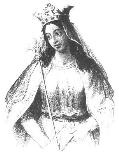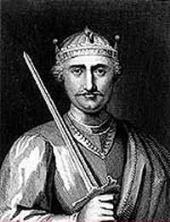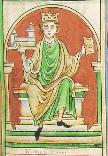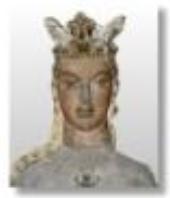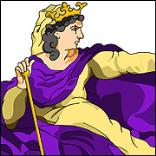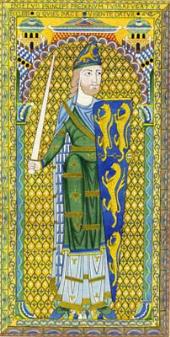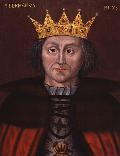See also
- Matilda 's parents: Baldwin V KING OF FLANDERS (1012-1067) and Alise of FRANCE ( - )
Matilda (1032- )
1. Matilda de Flandre, daughter of Baldwin V KING OF FLANDERS (1012-1067) and Alise of FRANCE ( - ), was born in 1032 in Flanders. She married William I KING OF ENGLAND in 1053 in Cathedrale Notre Dame d'Eu, Normandie.
William I KING OF ENGLAND, son of Robert I 6TH DUC DE NORMANDIE (999-1035) and Herleva de FALAISE (1003-c. 1050), was born circa [Julian] 1027. He died on [Julian] 9 September 1087. He and Matilda de Flandre had the following children:
| +2 | |
| +3 |
Second Generation
2. Henry I KING OF ENGLAND, son of William I KING OF ENGLAND and Matilda de Flandre, was born in [Julian] September 1068. He married Editha of Scotland on [Julian] 11 November 1100. He married Adeliza of Louvain on 2 February 1121. He died on [Julian] 1 December 1135. He was buried in Westminster Abbey. He married unknown lady.
Editha of Scotland (known as 'Matilda'), daughter of Malcolm III KING OF SCOTLAND (c. 1031-1093) and Saint Margaret "the Exile" (1045-1093), was born circa 1079 in Dunfermline, Fife, Scotland. She had the title 'Queen Consort Matilda'. She died on [Julian] 1 May 1118 in Westminster Palace. She and Henry I KING OF ENGLAND had the following children:
| +4 |
Adeliza of Louvain (also known as Adela, ALEIDIS), daughter of Godfrey I of Leuven, Duke of Lower Lotharingia (c. 1060-1139) and Ida ( - ), was born in 1103. She was a Queen Consort of the Kingdom of England. She died on 23 April 1151 in Abbey of Affligem, Brabant. She was buried in Abbey Church of Affligem.
unknown lady and Henry I KING OF ENGLAND had the following children:
| +5 |
3. Adela of England, daughter of William I KING OF ENGLAND and Matilda de Flandre, married Stephen COUNT OF BLOIS.
Stephen COUNT OF BLOIS and Adela of England had the following children:
| +6 |
Third Generation
4. Matilda of Normandy EMPRESS OF ENGLAND, daughter of Henry I KING OF ENGLAND and Editha of Scotland, was born circa [Julian] August 1102. She died on [Julian] 10 September 1167. She married Geoffrey V PLANTAGENET.
Geoffrey V PLANTAGENET was born on [Julian] 24 August 1113. He had the title 'Comte d'Anjou et Maine'. He died on [Julian] 7 September 1151. He and Matilda of Normandy EMPRESS OF ENGLAND had the following children:
| 7 | Henry II KING OF ENGLAND (1133-1189). Henry was born on [Julian] 5 March 1133. He had the title 'King of England'. He died on [Julian] 6 July 1189. |
5. Robert, 1st Earl of Gloucester, son of Henry I KING OF ENGLAND and unknown lady, was born in 1090. He died on 31 October 1147. He married Mabel of Gloucester.
Robert, 1st Earl of Gloucester (c. 1090 – October 31, 1147) was an illegitimate son of Henry I of England, and one of the dominant figures of the period of English history sometimes called the Anarchy. He is also known as Robert of Caen, and Robert "the Consul", though both names are used by later historians and have little contemporary justification, other than the fact that Robert's clerks made a practice of using the Latin word consul rather than the more common comes for his title of 'earl'.
Birth and Youth
Robert was the eldest of Henry's many illegitimate children. He was born well before his father's accession to the English throne, probably in the late 1080s, as he had himself had a son by 1104. His mother is not known for certain, though recent scholarship (D. Crouch) suggests she was a member of the Gay or Gayt family, minor English nobility in Oxfordshire one of whose members was called his cousin. Another suggestion (K. Thompson) is that his mother was a Norman woman who was connected to the Gays. William of Malmesbury refers to Robert's "Norman, Flemish, and French" and not English ancestry, but this may be a reference only to his father's side of the family.
Robert was acknowledged at birth, though in view of the vicissitudes of his father's career between 1087 and 1096 it is unlikely he was raised in his household. He was educated to a high standard, was literate in Latin and had a serious interest in both history and philosophy, which indicates that he was at least partly raised in a clerical household, a suggestion made all the more likely as his first known child, born around 1104, was born to a daughter of Bishop Samson of Worcester (died 1112) who up till 1096 had been a royal chaplain and treasurer of Bayeux. It may be significant that his next brother Richard was brought up in an episcopal household, that of the bishop of Lincoln.
Robert appears at court in Normandy in 1113, and around 1114 he married Mabel, eldest daughter and heir of Robert Fitzhamon, who brought him the substantial honor of Gloucester in England, Glamorgan in Wales and the honors of Sainte-Scholasse-sur-Sarthe and Évrecy in Normandy, as well as Creully. In 1121 or 1122 his father created him earl of Gloucester.
At the Court of Henry I
Robert developed a role as one of his father's principal aides and captains. In 1119, he fought at the Battle of Bremule, and in 1123-24 he was one of the king's chief commanders during the Norman rebellion. Following the drowning of the king's only legitimate son, William Adelin, in 1120, Robert became increasingly caught up in his father's attempts to ensure the succession of the Empress Mathilda, Robert's half-sister. It was to Robert's custody in his castle of Cardiff that his uncle, the deposed Duke Robert Curthose was eventually confided in 1126. On 1 January 1127 it was Robert who was one of the first to swear to accept Mathilda as queen after Henry's death. His father at some point gave him the keeping of the castles of Dover and Canterbury, and thus control of Kent and the cross-Channel route. When King Henry fell mortally ill at Lyons-la-Forêt in Normandy on 25 November 1135, Earl Robert was at his side and was one of the magnates who swore to stay with the king's body till it was buried. The king died a week after falling ill, on 1 December 1135.
Robert and King Stephen
After his father's death, Robert attended a series of conferences in Normandy and eventually accepted as king Theobald IV, count of Blois and King Henry's oldest nephew by his sister Adela. However, during the meeting with Theobald, news reach the Norman magnates that Theobald's younger brother, Stephen of Mortain and Boulogne, had been accepted and crowned as king in England. Robert eventually accepted this and at Easter 1136 attended the new king's ceremonial court. He does not seem to have seriously considered supporting the Empress Mathilda, and did not assist her invasion of southern Normandy. There is evidence in the contemporary source, the Gesta Stephani, that Robert was proposed by some as a candidate for the throne, but his illegitimacy ruled him out:
"Among others came Robert, Earl of Gloucester, son of King Henry, but a bastard, a man of proved talent and admirable wisdom. When he was advised, as the story went, to claim the throne on his father's death, deterred by sounder advice he by no means assented, saying it was fairer to yield it to his sister's son (the future Henry II of England), than presumptuously to arrogate it to himself."
This suggestion cannot have led to any idea that he and Stephen were rivals for the crown, as Geoffrey of Monmouth in 1136 referred to Robert as one of the 'pillars' of the new king's rule.
Robert of Gloucester had other distractions in 1136 which put the succession question out of his mind. The Welsh magnates of south east Wales rose against the Anglo-Norman settlers in April and Robert spent much of the year stabilising the situation. He reached peace treaties with the Welsh and recognised the gains of Morgan ab Owain (died 1158), who called himself king of Glamorgan. In England, Robert of Gloucester soon became disenchanted with King Stephen, and by the end of 1137 had withdrawn from his court. It is clear that he was disgruntled that he did not occupy the central place in politics that he had in the last reign. He was also alarmed at the favour with which the king regarded his Flemish mercenary general, William of Ypres, and the rising power of the Beaumont twins, Waleran, count of Meulan and Robert, earl of Leicester. In 1138, Robert declared his support for Matilda. Unfortunately he was defeated in Normandy by Waleran of Meulan and his English allies were crushed by Stephen and driven back on his fortress of Bristol.
The Civil War, 1139-1147
Earl Robert took a great gamble and sailed for England with his half-sister, the Empress, his wife and a company of knights. They landed at Arundel on 30 September 1139, and were welcomed into the castle there, the possession of Queen Adeliza, Mathilda's stepmother. Robert left for Bristol immediately. In his absence the castle was blockaded by King Stephen, opening the possibility that he might seize his dynastic rival. The king in the end let the empress and countess depart under escort to Bristol.
With Earl Robert and the Empress in England and based in the west country and Severn Valley, the civil war had begun. The earl's first moves are revealing. He commanded raids against Wareham in Dorset and Worcester. Both were possessions of the Beaumonts. He took Robert of Leicester's lands in Dorset for his own. He did much the same to other royalists within his area, mass deprivations which were at the heart of what is called the Anarchy. Although secure in a heartland of support, Earl Robert did not find it easy to recruit wider support and break out. The king succeeded in containing him along the line of the Cotswold Hills, with such effect that both sides were willing to send representatives to a peace conference held at Bath in August 1140, though nothing came of it.
Earl Robert's big opportunity came at Christmas 1140, when King Stephen fell out with Earl Ranulf II of Chester. Ranulf's failed negotations with the king to secure Lincoln Castle led him to ally with Robert, his father-in-law. They united their forces at Castle Donington in January 1141, including a host of Welsh mercenaries allied to Earl Robert. On 2 February 1141 the earls met and defeated King Stephen at the Battle of Lincoln. With the king captive, Empress Mathilda should have secured the throne, but a combination of stubborn royalist support, the empress's miscalculation and military misjudgement led to her failure. On 14 September 1141 Earl Robert and the Empress were trapped by a royalist army in an ill-judged attempt to seize control of Winchester. Earl Robert was captured fighting a rearguard action at the river crossing of Stockbridge to allow his sister to escape. Earl Robert was imprisoned for two months at Rochester Castle before he was released in an exchange with King Stephen. The cross-over point in the joint release was on 1 November 1141 at Winchester, where the two men had a chance to exchange friendly remarks, and the earl apparently assured the king that there was nothing personal in the fight as far as he was concerned.
The war continued and it rapidly became evident that it was a stalemate. The Empress's husband refused to commit the resources to tip the balance in England, only agreeing to discuss matters with the earl. In June 1142 Robert crossed from Wareham to Normandy and stayed there till the end of October. He came back with no reinforcements, but with his nephew Henry, the son of the Empress. In the meantime the Empress had been trapped in Oxford. Nothing could be done to release her, and she had to manage her own escape from the castle.
Robert continued the struggle but with less and less hope of ultimate victory. The king also had limited resources, but managed slowly to push towards Robert's centres of Bristol and Gloucester. At the end of 1145 Philip, Earl Robert's son and military captain, defected to Stephen, taking with him the strategic castles of Cricklade and Cirencester. With Gloucester and Bristol under threat, the earl opened negotiations in the autumn of 1146. The pressure continued in 1147, and it was in a desperate attack on Farnham in the late summer of that year that Earl Robert fought his last unsuccessful action of the war. He retired to Bristol to gather new forces, but became feverish. He died on 31 October 1147 and was buried in the priory of St James he had founded outside the castle.
Mabel of Gloucester, daughter of Robert FITZHAMON ( -1107) and Sibyl de Montgomery ( - ), died in 1156. She and Robert, 1st Earl of Gloucester had the following children:
| 8 | William FitzRobert, 2nd Earl of Gloucester (1116-1183). William was born on 23 November 1116. He died on 23 November 1183. |
6. Stephen de Blois, Count of Mortain KING OF ENGLAND, daughter of Stephen COUNT OF BLOIS and Adela of England, married Matilda de BOULOGNE.
One of ten children, his surviving brothers were Count Theobald II of Champagne, Henry of Blois, Bishop of Winchester, and William of Sully. He also had four sisters, including Eléonore of Blois.
Matilda de BOULOGNE, son of Eustace III EARL (COUNT) OF BOLOINE ( -c. 1125) and Mary of Scotland ( - ), died in 1151.
